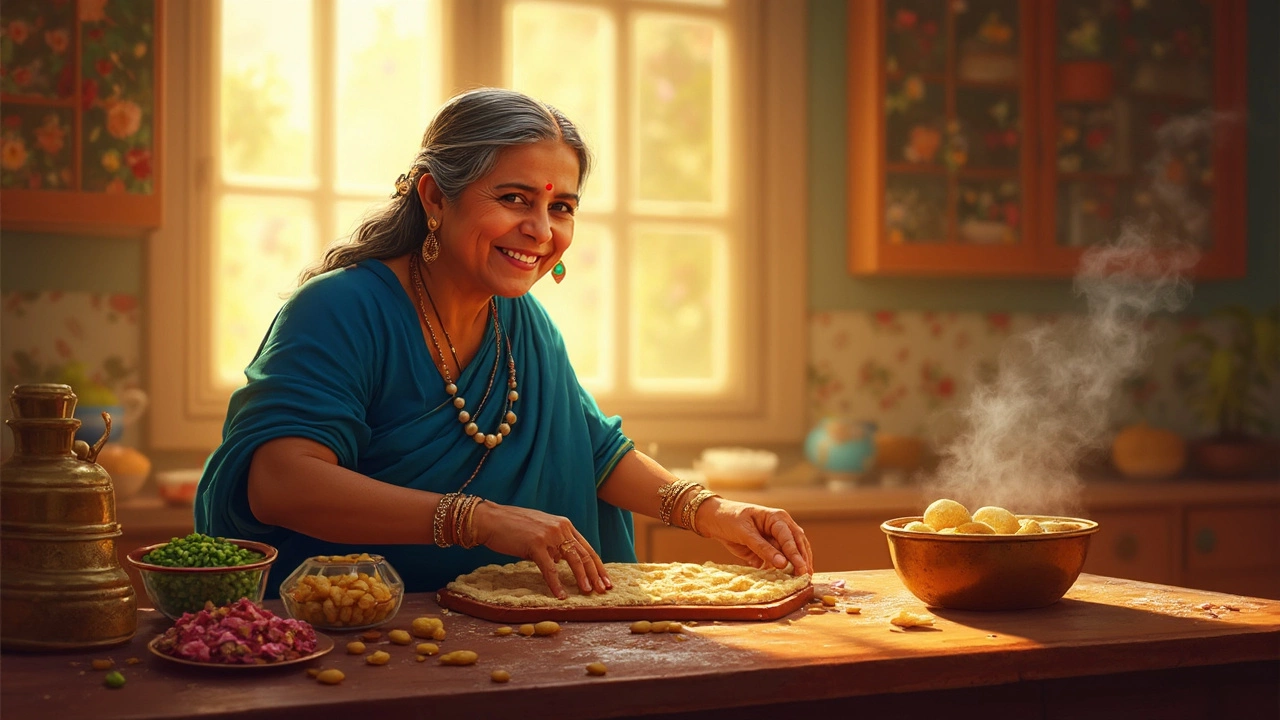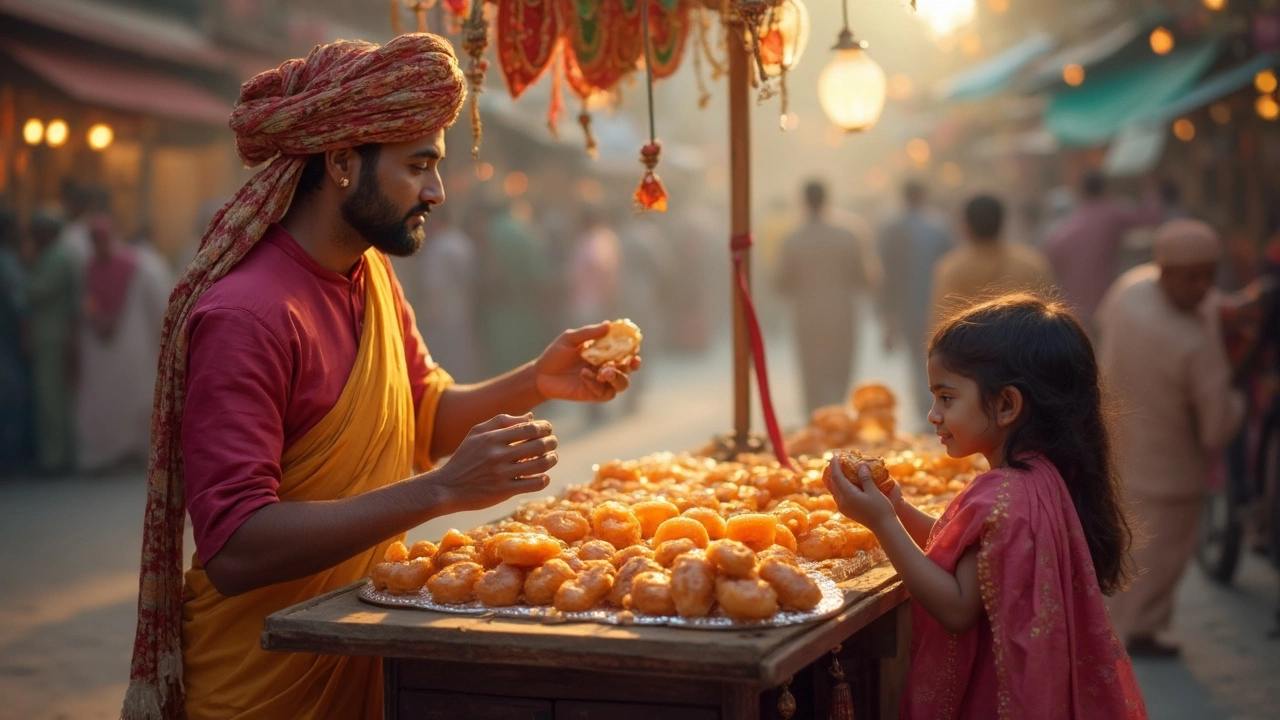India's love affair with sweets is legendary. You're probably wondering which sweet holds the coveted title of 'king' in a land brimming with sugar and spice. As it turns out, the answer depends on whom you ask and where you find yourself in India.
Each region has its champion, fiercely defended and celebrated in festivals and homes alike. In the north, you'll hear of Jalebi, its spirals thriving in hot syrup pools. Down south, the soft melt of Mysore Pak keeps taste buds busy. All these contenders foster debates about which is the true ruler.
But let's not shy away from making these at home. A tip if you're trying out Gulab Jamun: make sure the balls are fried slowly and evenly for that golden perfection. If Rasgulla is your pick, remember to use fresh chenna for the fluffiest results. It's all about practice and patience.
Understanding flavors and textures is like an art. Whether you lean towards the milky notes or the nutty crunch, finding that perfect sweet spot is the ultimate goal. So, what's your king of sweets?
- Introduction to Indian Sweets
- Regional Favorites
- Making the Perfect Sweet
- Conclusion: The Reigning King
Introduction to Indian Sweets
Step into the world of Indian sweets, and you're in for a treat! Boasting a rich tapestry of flavors and textures, this universe is as diverse as India's own cultural fabric. Indian sweets or "mithai" have a special place in the hearts and homes across the subcontinent, marking celebrations, festivals, and everyday life.
The beauty of these sweets lies not only in their taste but in their regional variations. Each state, or even city, might have its signature creation. For instance, the famous Bengali Rasgulla, known for its spongy, syrupy goodness, is a must-try. Meanwhile, Rajasthan presents the luxurious, nutty Gevar, usually enjoyed during the festive season.
Ever wonder how vast the range is? Let’s explore some quick stats:
| Region | Popular Sweet |
|---|---|
| North India | Jalebi, Gajar ka halwa |
| South India | Mysore Pak, Payasam |
| West India | Modak, Shrikhand |
| East India | Sandesh, Chomchom |
In India, sweets are not just desserts; they're a manifestation of celebration. Birthdays, weddings, and festivals like Diwali and Holi have this one thing in common: a sweet tradition that brings people together. Earlier, sweets were home-made with love, but now you can find them in sweet shops across the country, each offering its own twist on the classics.
The ingredients can also range from simple household items to more specialized additions. You'll often find items like milk, sugar, flour, nuts, and ghee making an appearance. But some recipes call for exotic spices like saffron or cardamom, adding an extra layer of sophistication.
Learning to make these Indian desserts at home can be surprisingly rewarding. If you're new to this, start with something straightforward like the humble yet satisfying Peda or perhaps a batch of sweet, syrupy Gulab Jamun. Each sweet tells its own story, one that is intertwined with the culture it hails from.
Regional Favorites
When it comes to Indian sweets, each region proudly boasts its own unique treats, often tied to local traditions and ingredients. In the bustling markets of North India, you'll find sweets like jalebi, those vibrant orange spirals, drenched in syrup and served hot. It's a breakfast favorite that pairs perfectly with spicy curries.
Head to the East, and you'll be greeted by the soft, spongy delights of rasgulla. These are especially famous in West Bengal and Odisha, each claiming to be the birthplace of this sweet wonder. Made from fresh chenna—Indian cottage cheese—rasgullas are boiled in sugar syrup until they achieve the perfect balance of sponginess and sweetness.
In South India, the sweet scene changes drastically. Here, you'll savor mysore pak—a buttery, crumbly sweet made from gram flour, ghee, and sugar. It originated in Mysore, Karnataka, and is a must-try for anyone visiting the region. During Diwali, making a perfect batch of mysore pak is almost an art form.
Western India, particularly Maharashtra, delights in puran poli. This sweet flatbread filled with jaggery and split chickpeas is usually made during festivals like Holi and Ganesh Chaturthi. It's the perfect mix of soft and crunchy, offering a delicious bite with every spoon of ghee that accompanies it.
Interestingly, in a recent survey on favorite Indian sweets, jalebi and rasgulla topped the charts, with over 65% of participants voting them as their go-to sweets in celebrations. This gives a fair idea of their popularity across various demographics.
| Region | Popular Sweet | Main Ingredient |
|---|---|---|
| North India | Jalebi | Maida (refined flour) |
| East India | Rasgulla | Chenna |
| South India | Mysore Pak | Gram flour |
| West India | Puran Poli | Gram and Jaggery |
So, when you're traversing India, don't forget to indulge in these regional delicacies. They tell a story of the land, its people, and their inherently sweet love for desserts.

Making the Perfect Sweet
Crafting the perfect Indian sweet at home can seem like a daunting task, but it doesn't have to be. Let's talk essentials and make sure those sugar-laden masterpieces come out like a pro's.
First up, pick your ingredients wisely. Freshness is key, especially if you're making sweets like Rasgulla or Gulab Jamun where the softness makes all the difference.
For starters, here’s a basic step-by-step on how to get those Gulab Jamuns just right:
- Use fresh khoya or milk powder to prepare the dough. The fresher it is, the better they’ll taste.
- Knead patiently until the dough is soft and smooth with no cracks. A little ghee can help achieve this consistency.
- Fry on low heat. High heat might brown them quickly but you risk a raw interior, so patience pays off here.
- Once golden, soak them in sugar syrup flavored with cardamom for a couple of hours to let them absorb all that sugary goodness.
Now, if Rasgulla is more your thing, remember these tips:
- Start with fresh chenna (paneer) and make sure it’s thoroughly kneaded until you can almost make a ball without cracks. A soft, smooth chenna is the secret.
- Boil them in thin sugar syrup, allowing space for them to expand. They need room to grow fluffy.
- Experiment with flavors by adding a hint of rose or saffron to the syrup for a twist.
Across India's kitchens, these methods have been perfected over generations. Practice a few times, and you’ll be serving up sweets worthy of the title King of Sweets. Just remember, taking the time to love what you're making always shines through in the final taste!
Conclusion: The Reigning King
So here's the big question: Is there really one true king of sweets in India? Let's be real, this crown is not so easily worn. With a country as diverse as India, it's more like a collection of rulers, each reigning supreme in its own territory.
Take the Gulab Jamun, for example. It's a universal favorite, found in nearly every Indian celebration. Those syrup-drenched balls are iconic and truly capture the sweetness that Indian desserts are known for. Yet, travel to Bengal and you'll find the Rasgulla holding its court, winning over fans with its spongy, syrupy goodness.
And let’s not forget about regional preferences. In Maharashtra, the Modak holds cultural and spiritual significance, especially during Ganesh Chaturthi. Meanwhile, Rajasthan boasts the eye-catching Ghevar during the festive Teej.
If we were to lean on data, a survey in 2024 showed that when asked to choose, a surprising 30% of Indians expressed a love for the humble Jalebi due to its crispy, syrupy allure.
| Dessert | Popularity (%) |
|---|---|
| Gulab Jamun | 40% |
| Jalebi | 30% |
| Rasgulla | 20% |
| Others | 10% |
In a land of such diversity, isn't it only fair to crown multiple rulers? They all bring their unique flavor to the table, making Indian sweets not just a treat, but a deeply rooted tradition that everyone can enjoy. Let's give a round of applause to them all!
